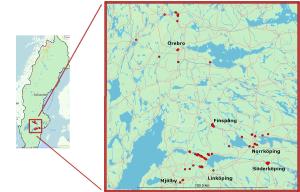Materials and Methods

Data collection has taken place over 18 years from 1999 to 2015 by Juhani Vuorinen. In order to ensure comparability, the same methods were followed even in 2016. Thereby, all of the known kingfisher nesting spots were visited several times a year. This includes 35 spots around Linköping municipality, 10 in Finspång, 6 in Mjölby, 13 in Norrköping, 9 in Söderköping and 13 Örebro municipality.
Under optimal conditions, a nest was visited at the beginning of the egg laying process, during the incubation time and after the hatching in order to ring the nestlings. Places that indicated kingfisher activity but no nestings were checked occasionally in order to observe nesting starts. Places without sign of activity were optimally visited at the beginning, in the middle and at the end of the season, to confirm empty holes or ring possible chicks. During the visits, each hole in the bank was controlled. A metal stick with a bendable mirror at the end and a strong light were thereby used to reflect the inner of the nest chamber. The number of eggs was counted, and, if incubation was ongoing, the incubating adult caught, ringed and weighed with a spring scale. Nestlings were old enough to be ringed after day six, when the legs were big enough to support a ring and the chicks strong enough to spend a short while outside the nest. They were taken out of the chamber with a forked and rubbered metal stick and collected into a woolen bag. Every chick was ringed and weighed and returned into the nest.
Additionally, for each nesting site in Linköping, data of the breeding habitat was collected in 2016. With a measuring stick, the distance from the breeding wall to the closest water course was measured. A compass was used to determine the orientation of the hole’s entrance. Soil samples were collected next to the entrance of the hole and a simple clay test (Lunds Universitet 1988)) of the soil was performed. A frontal photo was taken and the wall size calculated on the computer with the program Gimp GNU Image Manipulation Program, Version 2.8. Thereby, the amount of surface that possibly could be used for drilling a hole as being wall was chosen.
All statistical analyses were carried out in R (R Core Team 2016), using linear modeling to test for relationships. Possible correlations as well as normal distri-bution and possible trends of the residuals were assessed visually, and if necessary data was log transformed to fit the assumption of normality.

Responsible for this page:
Director of undergraduate studies Biology
Last updated:
05/11/17
